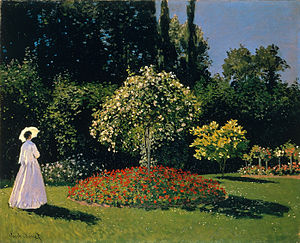
Oscar-Claude Monet was a French painter and founder of impressionist painting who is seen as a key precursor to modernism, especially in his attempts to paint nature as he perceived it. During his long career, he was the most consistent and prolific practitioner of impressionism's philosophy of expressing one's perceptions of nature, especially as applied to plein air (outdoor) landscape painting. The term "Impressionism" is derived from the title of his painting Impression, soleil levant, exhibited in 1874 initiated by Monet and his associates as an alternative to the Salon.

Pierre-Auguste Renoir was a French artist who was a leading painter in the development of the Impressionist style. As a celebrator of beauty and especially feminine sensuality, it has been said that "Renoir is the final representative of a tradition which runs directly from Rubens to Watteau."
Events from the year 1867 in art.
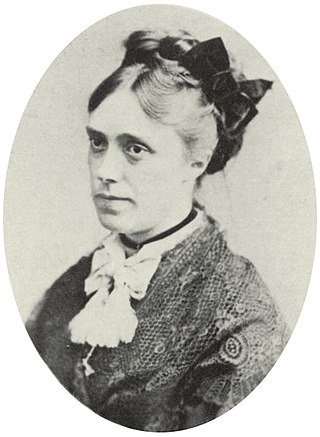
Camille-Léonie Doncieux was the first wife of French painter Claude Monet, with whom she had two sons. She was the subject of a number of paintings by Monet, as well as Pierre-Auguste Renoir and Édouard Manet.

Water Lilies is a series of approximately 250 oil paintings by French Impressionist Claude Monet (1840–1926). The paintings depict his flower garden at his home in Giverny, and were the main focus of his artistic production during the last thirty years of his life. Many of the works were painted while Monet suffered from cataracts.

Sainte-Adresse is a commune in the Seine-Maritime department in the region of Normandy, France.

Artizon MuseumAatizon Bijutukan (アーティゾン美術館), until 2018 Bridgestone Museum of Art, is an art museum in Tokyo, Japan.

The Garden at Sainte-Adresse is a painting by the French impressionist painter Claude Monet.. The painting was acquired by the Metropolitan Museum of Art after an auction sale at Christie's in December 1967, under the French title La terrasse à Sainte-Adresse. The painting was exhibited at the 4th Impressionist exhibition, Paris, April 10–May 11, 1879, as no. 157 under the title Jardin à Sainte-Adresse.

Bain à la Grenouillère is an 1869 painting by the French impressionist painter, Claude Monet.. It depicts "Flowerpot Island", also known as the Camembert, and the gangplank to La Grenouillère, a floating restaurant and boat-hire on the Seine at Croissy-sur-Seine. He was accompanied by Pierre-Auguste Renoir, who also painted the scene at the same time.

The Regatta at Sainte-Adresse is an oil-on-canvas painting by the impressionist painter Claude Monet. It was painted in 1867 and is owned by the Metropolitan Museum of Art.

Blanche Hoschedé Monet was a French painter who was both the stepdaughter and the daughter-in-law of Claude Monet.
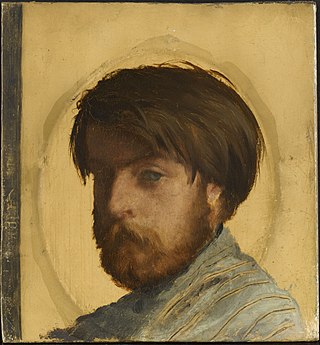
Auguste Toulmouche was a French painter known for his luxurious genre paintings of upper middle class Parisian women in domestic scenes.
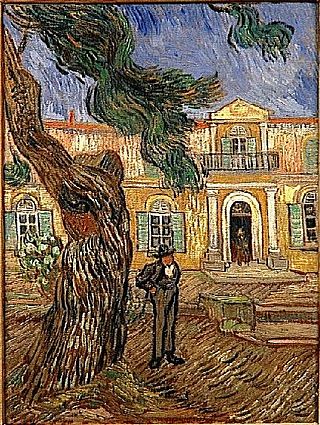
Saint-Paul Asylum, Saint-Rémy is a collection of paintings that Vincent van Gogh made when he was a self-admitted patient at the Saint-Paul asylum in Saint-Rémy-de-Provence, since renamed the Clinique Van Gogh, from May 1889 until May 1890. During much of his stay there he was confined to the grounds of the asylum, and he made paintings of the garden, the enclosed wheat field that he could see outside his room and a few portraits of individuals at the asylum. During his stay at Saint-Paul asylum, Van Gogh experienced periods of illness when he could not paint. When he was able to resume, painting provided solace and meaning for him. Nature seemed especially meaningful to him, trees, the landscape, even caterpillars as representative of the opportunity for transformation and budding flowers symbolizing the cycle of life. One of the more recognizable works of this period is The Irises. Works of the interior of the hospital convey the isolation and sadness that he felt. From the window of his cell he saw an enclosed wheat field, the subject of many paintings made from his room. He was able to make but a few portraits while at Saint-Paul.

The Fondation Claude Monet is a nonprofit organisation that runs and preserves the house and gardens of Claude Monet in Giverny, France, where Monet lived and painted for 43 years. Monet was inspired by his gardens, and spent years transforming them, planting thousands of flowers. He believed that it was important to surround himself with nature and paint outdoors. He created many paintings of his house and gardens, especially of water lilies in the pond, the Japanese bridge, and a weeping willow tree.
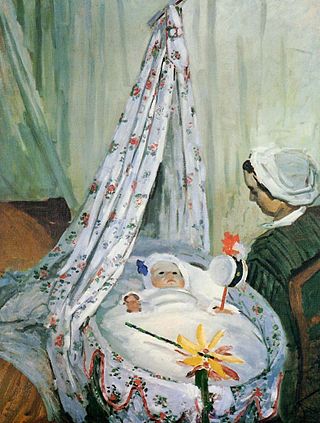
Jean Monet was the eldest son of French Impressionist artist Claude Monet and Camille Doncieux Monet and the brother of Michel Monet. He was the subject of several paintings by his father and married his step-sister, Blanche Hoschedé.

The Artist's Garden at Giverny is an oil on canvas painting by Claude Monet done in 1900, now in the Musée d'Orsay, Paris.

Argenteuil is an 1874 oil on canvas painting by Édouard Manet (1832-1883), first exhibited at the Paris Salon of 1875. It is one of Manet's first works to qualify fully as an Impressionist work, due to its naturalistic subject and its bold palette, such as the blue of the river, mocked by the Figaro journalist Jean Rousseau as "in the foreground, Argenteuil jam on an indigo river" It is now in the Musée des beaux-arts in Tournai, Belgium.

Garden at Bordighera, Morning is an 1884 oil on canvas painting by Claude Monet, now in the Otto Krebs collection at the Hermitage Museum, first displayed to the public in 1995.

The Seine at Rouen is an 1872 oil on canvas painting by Claude Monet, now part of the Otto Krebs collection at the Hermitage Museum in Saint Petersburg. It shows a sunny scene of sailing boats moored by the quays on the Seine in Rouen.

A Corner in the Garden at Montgeron is an oil on canvas painting by Claude Monet, from 1876. It is held in the Hermitage Museum, in Saint Petersburg.
